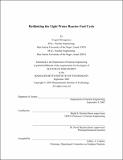| dc.contributor.advisor | Mujid S. Kazimi and Pavel Hejzlar. | en_US |
| dc.contributor.author | Shwageraus, Evgeni | en_US |
| dc.contributor.other | Massachusetts Institute of Technology. Dept. of Nuclear Engineering. | en_US |
| dc.date.accessioned | 2005-05-17T14:46:07Z | |
| dc.date.available | 2005-05-17T14:46:07Z | |
| dc.date.copyright | 2003 | en_US |
| dc.date.issued | 2004 | en_US |
| dc.identifier.uri | http://hdl.handle.net/1721.1/16641 | |
| dc.description | Thesis (Ph. D.)--Massachusetts Institute of Technology, Dept. of Nuclear Engineering, February 2004. | en_US |
| dc.description | Includes bibliographical references (p. 249-262). | en_US |
| dc.description | This electronic version was submitted by the student author. The certified thesis is available in the Institute Archives and Special Collections. | en_US |
| dc.description.abstract | The once through nuclear fuel cycle adopted by the majority of countries with operating commercial power reactors imposes a number of concerns. The radioactive waste created in the once through nuclear fuel cycle has to be isolated from the environment for thousands of years. In addition, plutonium and other actinides, after the decay of fission products, could become targets for weapon proliferators. Furthermore, only a small fraction of the energy potential in the fuel is being used. All these concerns can be addressed if a closed fuel cycle strategy is considered offering the possibility for partitioning and transmutation of long lived radioactive waste, enhanced proliferation resistance, and improved utilization of natural resources. It is generally believed that dedicated advanced reactor systems have to be designed in order to perform the task of nuclear waste transmutation effectively. The development and deployment of such innovative systems is technically and economically challenging. In this thesis, a possibility of constraining the generation of long lived radioactive waste through multi-recycling of Trans-uranic actinides (TRU) in existing Light Water Reactors (LWR has been studied. Thorium based and fertile free fuels (FFF) were analyzed as the most attractive candidates for TRU burning in LWRs. Although both fuel types can destroy TRU at comparable rates (about 1150 kg/GWe-Year in FFF and up to 900 kg/GWe-Year in Th) and achieve comparable fractional TRU burnup (close to 50a/o), the Th fuel requires significantly higher neutron moderation than practically feasible in a typical LWR lattice to achieve such performance. | en_US |
| dc.description.abstract | (cont.) On the other hand, the FFF exhibits nearly optimal TRU destruction performance in a typical LWR fuel lattice geometry. Increased TRU presence in LWR core leads to neutron spectrum hardening, which results in reduced control materials reactivity worth. The magnitude of this reduction is directly related to the amount of TRU in the core. A potential for positive void reactivity feedback limits the maximum TRU loading. Th and conventional mixed oxide (MOX) fuels require higher than FFF TRU loading to sustain a standard 18 fuel cycle length due to neutron captures in Th232 and U238 respectively. Therefore, TRU containing Th and U cores have lower control materials worth and greater potential for a positive void coefficient than FFF core. However, the significantly reduced fuel Doppler coefficient of the fully FFF loaded core and the lower delayed neutron fraction lead to questions about the FFF performance in reactivity initiated accidents. The Combined Non-Fertile and UO2 (CONFU) assembly concept is proposed for multi- recycling of TRU in existing PWRs. The assembly assumes a heterogeneous structure where about 20% of the UO2 fuel pins on the assembly periphery are replaced with FFF pins hosting TRU generated in the previous cycle. The possibility of achieving zero TRU net is demonstrated. The concept takes advantage of superior TRU destruction performance in FFF allowing minimization of TRU inventory. At the same time, the core physics is still dominated by UO2 fuel allowing maintenance of core safety and control characteristics comparable to all-UO2. | en_US |
| dc.description.statementofresponsibility | by Evgeni Shwageraus. | en_US |
| dc.format.extent | 281 p. | en_US |
| dc.format.extent | 1913547 bytes | |
| dc.format.extent | 2047425 bytes | |
| dc.format.mimetype | application/pdf | |
| dc.format.mimetype | application/pdf | |
| dc.language.iso | eng | en_US |
| dc.publisher | Massachusetts Institute of Technology | en_US |
| dc.rights | M.I.T. theses are protected by copyright. They may be viewed from this source for any purpose, but reproduction or distribution in any format is prohibited without written permission. See provided URL for inquiries about permission. | en_US |
| dc.rights.uri | http://dspace.mit.edu/handle/1721.1/7582 | |
| dc.subject | Nuclear Engineering. | en_US |
| dc.title | Rethinking the light water reactor fuel cycle | en_US |
| dc.type | Thesis | en_US |
| dc.description.degree | Ph.D. | en_US |
| dc.contributor.department | Massachusetts Institute of Technology. Department of Nuclear Engineering | en_US |
| dc.contributor.department | Massachusetts Institute of Technology. Department of Nuclear Science and Engineering | |
| dc.identifier.oclc | 56203443 | en_US |
